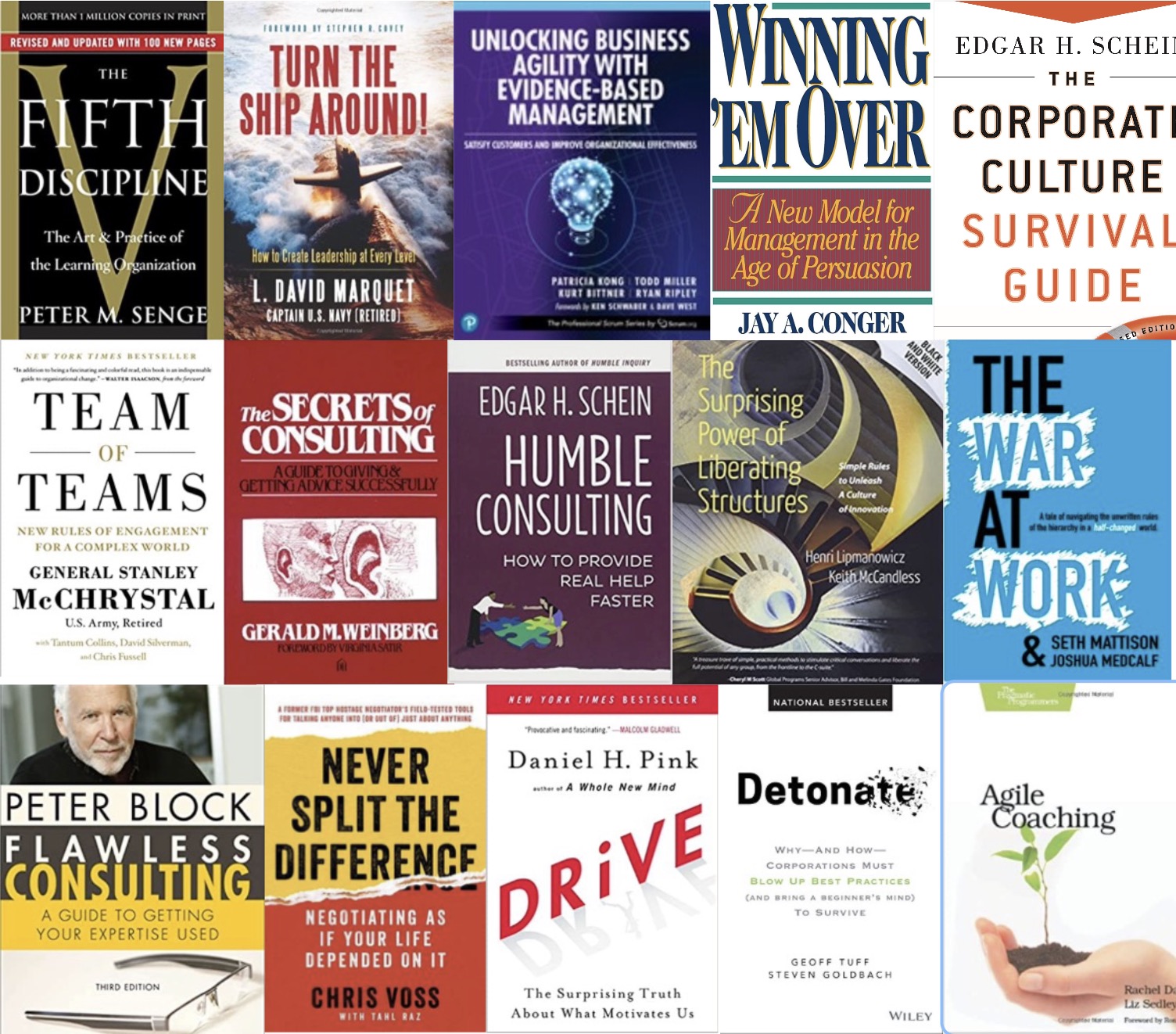In a previous article titled Scrum Master Level Up, I listed 18 books that I recommend you read to develop your knowledge beyond the training course you may have been given at your company to start you on this path. My recommendations included:
- Memorize the Scrum Guide. Not so you can recite it, but how can you referee a game when you don’t know the rules well enough to apply them in real-time?
- Learn about empiricism, lean thinking, and empowered teams, and what those mean.
- Be able to tie the elements of Scrum to the creation of those condition of empiricism, lean thinking, and empowered teams.
A More Advanced Path
These books are not harder to read. You could study them deeply without looking at any of the previous books I recommended in the other article. However, the reason they are separated is because the other books addressed directly your ability to understand what Scrum does and why it does it, and therefore teach it to people effectively and explain value lost when they want to remove elements. I was also trying to give you alternatives, such as Kanban, to which you could pivot effectively when it is clear that a team is not doing complex work or you are in an environment where doing Scrum will get everyone in trouble… or worse. Those were more immediate skills to learn.
This next path is more about deepening your understanding – particularly as a consultant. When I write the word consultant, I do not mean someone who is paid by the hour and wears a suit. I mean a very specific thing. A consultant is paid to influence people at their request. It is time for every Scrum Master to learn that they are a consultant, whether they are an internal employee of their company or a contractor, and learn the skills that consultants know that allow them to do their jobs.
Problem Solving
Senge, P. M. (2006). The fifth discipline: The art and practice of the learning organization (Rev. ed.). Crown Business. Peter Senge (pronounced Sen-gay) has written a book on how to build a learning organization and provides his unique viewpoint on problem solving as being a process of understanding cyclical processes involved in problems.
Bong, P., Miller, T., Ripley, R., & Kniberg, H. (2020). Unlocking business agility with evidence-based management: Satisfy customers and improve organizational effectiveness. Scrum.org. Scrum.org does some interesting stuff on their site to expand the advice they are giving based on their worldview of empiricism as being incredibly important to business management. They created Nexus, a way to scale using a single product owner and backlog with several scrum teams. They created a guide called Professional Scrum with Kanban that presents a way to use Kanban and Scrum fully together, rejecting the idea of Scrumban by Corey Ladas that modifies Scrum. They have also released a white paper on Evidence Based Management which they call the Evidence Based Management Guide. Four PST’s within the organization worked together to create this book which details their point of view on using empiricism in strategic planning filling in gaps between organizational goals and the goals of individuals or teams on the line. It is a powerful book. It only has one connection with Scrum: Are you using value measures to make decisions? Highly recommended for managers and Scrum Masters alike.
Empowered Teams
McChrystal, S., Collins, T., Silverman, D., & Fussell, C. (2015). Team of teams: New rules of engagement for a complex world. Portfolio. Retired US Army General Stanley McChrystal talks about fighting a modern war by building a team of teams to push down decision making and turn the org chart upside down. If a general can move to a supporting stance, surely any organizational leader can do this.
Marquet, L. D. (2013). Turn the ship around!: How to create leadership at every level. Portfolio Penguin. Another military commander, this time the Captain of a US Navy nuclear submarine the USS Santa Fe, implements pushing decision making down to the line and removing himself as a bottleneck in all possible cases. An amazing story of how the world’s most dangerous environment is able to adopt modern management techniques to lead a crew to amazing success.
Mattison, S., & Medcalf, J. (2018). The war at work: A tale of navigating the unwritten rules of the hierarchy in a half-changed world. Lioncrest Publishing. A great story about a manager realizing the difference between network and hierarchy. For people working in a company using the Scaled Agile Framework, this should be pretty familiar. The Network-on-Hierarchy is the value stream identification and ART construction from SAFE. This book has nothing to do with SAFE, it isn’t even a software development book. It’s a book about organizing around value rather than organizing around a control structure, in this case, an organizational chart.
Pink, D. H. (2009). Drive: The surprising truth about what motivates us. Riverhead Books. The original book about autonomy, mastery, and purpose. I still think Pink left one item off the list, but that’s my thought for my own article one day. This is a great book that takes a look at the science of managing people and how the more we seek control, the more we lose performance.
Consulting
Why are there books about culture and consulting here? Because too many Agile Coaches and Scrum Masters think that telling management what they really think is going to get them a good result. Good coaching is consulting. Consulting does not consist of telling people they are wrong and how to do things right. Very few people want to hear that they are wrong. These books provide you with a sound approach that will allow you to begin to have influence and build that influence over time.
Schein, E. H. (2009). The corporate culture survival guide (2nd ed.). Jossey-Bass. Ed Schein was the world’s top voice on culture. Culture is not having parties or couches in the office. Culture is everything we do and say because of everything we assume and believe. When you understand corporate culture after reading this book, you may feel a little depressed about your previous dreams of overthrowing the previous way of working in favor of a new one, but you will also understand why there are so many failed agile adoptions out there in the Fortune 500. You will also start to see a path to do something about it that will not result in your unemployment.
Schein, E. H. (2016). Humble consulting: How to provide real help faster. Berrett-Koehler Publishers. An approach to consulting which every SM and coach need to add to the quality of their bedside manner.
Block, P. (2011). Flawless consulting: A guide to getting your expertise used (3rd ed.). Jossey-Bass. Block’s book is a how-to guide on everything from finding clients to writing contracts to negotiating the results of those contracts. He also has some key insights on how management thinks, and what they hire consultants to do. Make no mistake, if you are an SM, you are a consultant, whether you wanted to be one or not.
Weinberg, G. M. (1985). The secrets of consulting: A guide to giving and getting advice successfully. Dorset House Publishing. Another insightful book on how to do your job without getting fired. So many important principles, stories and rules here. Remember, the cucumber gets pickled more than the brine gets cucumbered. This is a must-read.
Conger, J. A. (2001). Winning ’em over: A new model for management in the age of persuasion. Free Press. Another must-read, Congers easily accessible book explains how to tell what your expertise and influence is and what approach to take. I had this book on my shelf for over a decade without having read it. My father bought it for me telling me that he found it at a Goodwill store and that within it were secrets I needed to know to do my job. I didn’t listen. I finally read it, and when I did, my eyes practically popped out of my head. One of the most helpful works I have ever read. Don’t skip it.
Facilitation
Lipmanowicz, H., & McCandless, K. (2014). The surprising power of liberating structures: Simple rules to unleash a culture of innovation. Liberating Structures Press. This is a book filled with 48 or so different types of facilitation techniques to use to manage rooms with numbers of people in them that make “going around the table” a huge pain. Consider trying them in some of your Scrum events. Consider even more the possibility that you might one day be asked to do a workshop or train a brand new team for a couple of days, and you might need some of these techniques to help the event be more interesting. Be careful though – too much facilitation technique quickly turns into a terrible meeting just as much as one that is not facilitated.
Davies, R., & Sedley, L. (2009). Agile coaching. Pragmatic Bookshelf. This is a great book on coaching a team that is trying to do Agile. There are a lot of thoughts in this book that were very original at the time they were first published, and they still might be original for you today. Most people turn to Lyssa Adkin’s book in on Agile Coaching when asked for a textbook on how to do it. I prefer Davies work, thought Adkins’ book is also highly valuable.
Tuff, G., & Goldbach, S. (2018). Detonate: Why—and how—corporations must blow up best practices (and bring a beginner’s mind) to survive. Wiley. Detonate is a book about “how we do things around here and why that needs to change and how. Some people find it mind blowing, and others read it and say, “Eh. Yeah. Whatever.” I was one of the second the first time I read it, but the second read put in the first category. Don’t miss this one.
Voss, C., & Raz, T. (2016). Never split the difference: Negotiating as if your life depended on it. Harper Business. This powerful book could be a pathway to many abilities some consider to be unnatural! Chris Voss was a senior hostage negotiator for the FBI. His book on negotiation is so powerful that after you read it, you will want to have others practice the techniques with you. I use labeling every day all the time to show listening. His model is the Steel Man: understanding the other person so completely that you can describe what they are feeling and why so well that they say “That’s right.” You probably aren’t listening well enough. Read this book and get good at understanding and stop pushing “because the Scrum Guide says.” You might learn things you did not expect to learn.
This is Just The Beginning
I wrote this in the previous Scrum Master Level Up article and I want to double down on it here:
Reading a wide range of works will not only teach you the why behind everything in your field, but it will also give you confidence that you’re on the right track, even with things you haven’t yet had the opportunity to try yourself.
Reading is humanity’s secret weapon. It enables us to learn from others’ experiences without suffering their consequences. Through books, we skip to the front of the line and stand on the shoulders of giants.
Read.


